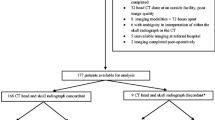Abstract
Background
Some data suggest that CT is more accurate than skull radiographs in diagnosing skull fractures in abusive head trauma.
Objectives
We investigated whether multiplanar CT with three-dimensional (3-D) reconstructions alone is non-inferior to combination CT/skull radiography for the diagnosis of skull fracture in suspected physical abuse.
Materials and methods
We identified children who had skull radiographs and concurrent multiplanar CT with 3-D reconstructions obtained during suspected physical abuse imaging between 2010 and 2019, and a fracture diagnosis in the formal report. We included all fracture cases and an equal number of randomly selected non-fracture controls in an anonymised dataset. This dataset was independently reviewed for skull fracture by two paediatric radiologists and one less-experienced trainee using either radiography alone, CT alone or CT/skull radiography. The primary outcome was discordance in diagnosis of skull fracture between CT alone and CT/skull radiography, with a result > 0.03 deemed to indicate inferiority of CT alone. The Fleiss kappa was used to assess interobserver agreement.
Results
We included 106 children, 53 with and 53 without skull fracture. A single case was discordant between CT alone and CT/skull radiography, resulting in discordance of 0.009, consistent with non-inferiority of CT alone. The sensitivity and specificity of CT alone and CT/skull radiography were 98% and 96–98%, respectively, whereas radiography alone was more inaccurate (81% sensitivity and 96% specificity). Interobserver agreement for all modalities was very high (kappa 0.86–0.95).
Conclusion
Multiplanar CT with 3-D reconstructions alone is not inferior (and clinically equivalent) to CT/skull radiography for diagnosing skull fracture in suspected physical abuse imaging and was as accurate when reported by a less-experienced trainee. This suggests that skull radiography can be removed from suspected physical abuse imaging guidelines.






Similar content being viewed by others
References
Hsieh KL, Zimmerman RA, Kao HW, Chen CY (2015) Revisiting neuroimaging of abusive head trauma in infants and young children. AJR Am J Roentgenol 204:944–952
Society and College of Radiographers, Royal College of Radiologists (2018) The radiological investigation of suspected physical abuse in children, revised first edition. https://www.rcr.ac.uk/system/files/publication/field_publication_files/bfcr174_suspected_physical_abuse.pdf. Accessed 1 Oct 2021
Rajaram S, Batty R, Rittey CD et al (2011) Neuroimaging in non-accidental head injury in children: an important element of assessment. Postgrad Med J 87:355–361
Nixon JN, Soares BP (2016) Imaging of abusive head trauma: a review and update. Curr Radiol Rep 4
Wootton-Gorges SL, Soares BP, Alazraki AL et al (2017) ACR appropriateness criteria: suspected physical abuse — child. Am Coll Radiol 14:S338–S349
Ewing-Cobbs L, Kramer L, Prasad M et al (1998) Neuroimaging, physical, and developmental findings after inflicted and noninflicted traumatic brain injury in young children. Pediatrics 102:300–307
Jenny C, Hymel KP, Ritzen A et al (1999) Analysis of missed cases of abusive head trauma. JAMA 281:621
Barlow KM, Thomson E, Johnson D, Minns RA (2005) Late neurologic and cognitive sequelae of inflicted traumatic brain injury in infancy. Pediatrics 116:e174–e185
Teeuw AH, Kraan RBJ, van Rijn RR et al (2019) Screening for child abuse using a checklist and physical examination in the emergency department led to the detection of more cases. Acta Paediatr 108:300–313
Webb L, Kelly P (2016) Abuse and neglect. Starship clinical guidelines. https://www.starship.org.nz/guidelines/abuse-and-neglect/. Accessed 27 Sep 2019
Phillips KL, Bastin ST, Davies-Payne D et al (2015) Radiographic skeletal survey for non-accidental injury: systematic review and development of a national New Zealand protocol. J Med Imaging Radiat Oncol 59:54–65
Martin A, Paddock M, Johns CS et al (2019) Avoiding skull radiographs in infants with suspected inflicted injury who also undergo head CT: “a no-brainer?” Eur Radiol 30:1480–1487
Sharp SR, Patel SM, Brown RE, Landes C (2018) Head imaging in suspected non accidental injury in the paediatric population. In the advent of volumetric CT imaging, has the skull X-ray become redundant? Clin Radiol 73:449–453
Culotta PA, Crowe JE, Tran QA et al (2016) Performance of computed tomography of the head to evaluate for skull fractures in infants with suspected non-accidental trauma. Pediatr Radiol 47:74–81
Orman G, Wagner MW, Seeburg D et al (2015) Pediatric skull fracture diagnosis: should 3D CT reconstructions be added as routine imaging? J Neurosurg Pediatr 16:426–431
Starship (2020) Plain films — skeletal survey. Starship clinical guidelines. https://www.starship.org.nz/guidelines/plain-films-skeletal-survey/. Accessed 1 Feb 2020
Lu Y, Jin H, Genant HK (2003) On the non-inferiority of a diagnostic test based on paired observations. Stat Med 22:3029–3044
Sanchez T, Stewart D, Walvick M, Swischuk L (2010) Skull fracture vs. accessory suture: how can we tell the difference? Emerg Radiol 17:413–418
Flom L, Fromkin J, Panigrahy A et al (2016) Development of a screening MRI for infants at risk for abusive head trauma. Pediatr Radiol 46:519–526
Author information
Authors and Affiliations
Corresponding author
Ethics declarations
Conflicts of interest
None
Additional information
Publisher's note
Springer Nature remains neutral with regard to jurisdictional claims in published maps and institutional affiliations.
Rights and permissions
About this article
Cite this article
Cosgrave, L., Bowie, S., Walker, C. et al. Abusive head trauma in children: radiographs of the skull do not provide additional information in the diagnosis of skull fracture when multiplanar computed tomography with three-dimensional reconstructions is available. Pediatr Radiol 52, 924–931 (2022). https://doi.org/10.1007/s00247-021-05256-9
Received:
Revised:
Accepted:
Published:
Issue Date:
DOI: https://doi.org/10.1007/s00247-021-05256-9




